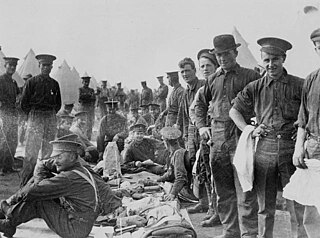
The North Saskatchewan Regiment is a Primary Reserve infantry regiment of the Canadian Army, headquartered in Saskatoon, Saskatchewan, with companies in Saskatoon and Prince Albert. Its current commanding officer is Lieutenant-Colonel Tom Mykytiuk. The N Sask R is part of the 3rd Canadian Division's 38 Canadian Brigade Group.
The 188th (Saskatchewan) Battalion, CEF was a unit in the Canadian Expeditionary Force during the First World War. Based in Prince Albert, Saskatchewan, the unit began recruiting during the winter of 1915/16 throughout northern Saskatchewan. After sailing to England in October 1916, the battalion was absorbed into the 15th Reserve Battalion on January 4, 1917. The 188th (Saskatchewan) Battalion, CEF had one Officer Commanding: Lieut-Col. S. J. Donaldson.
The 128th Battalion, CEF was a unit in the Canadian Expeditionary Force during the First World War. Based in Moose Jaw, Saskatchewan, the unit began recruiting in late 1915 in that city and the surrounding district. After sailing to England in August 1916, the battalion was absorbed into the 15th and 19th Reserve Battalions on August 24, 1916. The 128th Battalion, CEF had one Officer Commanding: Lieut-Col. F. Pawlett.
The 152nd Battalion was a unit of the Canadian Expeditionary Force during the Great War. It was authorized on 22 December 1915, recruiting in Weyburn and Estevan, Saskatchewan, and embarked for Great Britain on 3 October 1916, where its personnel were absorbed by the 32nd Reserve Battalion, CEF, on 21 October 1916 to provide reinforcements for the Canadian Corps in the field. The battalion was disbanded on 21 May 1917.
The 195th Battalion, CEF was a unit in the Canadian Expeditionary Force during the First World War. Based in Regina, Saskatchewan, the unit began recruiting during the winter of 1915/16 in that city. After sailing to England in November 1916, the battalion was absorbed into the 32nd Reserve Battalion on November 11, 1916. The 195th Battalion, CEF had one Officer Commanding: Lieut-Col. A. C. Garner.
The 209th Battalion, CEF, was a unit in the Canadian Expeditionary Force during the First World War. Based in Swift Current, Saskatchewan, the unit began recruiting in early 1916 in that city and surrounding district. After sailing to England in November 1916, the battalion was absorbed into the 9th Reserve Battalion on January 4, 1917. The 209th Battalion, CEF, had one officer commanding: Lieutenant-Colonel W.O. Smyth. The battalion was disbanded on May 21, 1917.
The 210th (Frontiersmen) Battalion, CEF was a unit in the Canadian Expeditionary Force during the First World War. Based in Moose Jaw, Saskatchewan, the unit was raised by the local Legion of Frontiersmen in early 1916 in that city and surrounding district. After sailing to England in April 1917, the battalion was absorbed into the 19th Reserve Battalion on April 22, 1917. The 210th (Frontiersmen) Battalion, CEF had one Commanding Officer: Lieut-Col. W. E. Seaborn. The Battalion was awarded the Battle Honour "Honour of the Great War".
The 214th (Saskatchewan) Battalion, CEF was a unit in the Canadian Expeditionary Force during the First World War. Based in Wadena, Saskatchewan, the unit began recruiting in early 1916 in the districts of Mackenzie and Humboldt. After sailing to England in April 1917, the battalion was absorbed into the 15th Reserve Battalion on April 29, 1917. The 214th (Saskatchewan) Battalion, CEF had one Officer Commanding: Lieut-Col. J. H. Hearn.
The 217th Battalion, CEF was a unit in the Canadian Expeditionary Force during the First World War. Based in Moosomin, Saskatchewan, the unit began recruiting in early 1916 throughout the district. After sailing to England in June 1917, the battalion was absorbed into the 19th Reserve Battalion on June 9, 1917. The 217th Battalion, CEF had one Officer Commanding: Lieut-Col. A. B. Gillis.
The 229th Battalion, CEF was a unit in the Canadian Expeditionary Force during the First World War. Based in Moose Jaw, Saskatchewan, the unit began recruiting in early 1916 in southern Saskatchewan. After sailing to England in April 1917, the battalion was absorbed into the 19th Reserve Battalion on May 10, 1917. The 229th Battalion, CEF had one Officer Commanding: Lieut-Col. H. D. Pickett.
The 232nd (Saskatchewan) Battalion, CEF was a unit in the Canadian Expeditionary Force during the First World War. Based in North Battleford, Saskatchewan, the unit began recruiting in early 1916 in that town and the surrounding district. After sailing to England in April 1917, the battalion was absorbed into the 15th Reserve Battalion on June 9, 1917. The 232nd (Saskatchewan) Battalion, CEF had one Officer Commanding: Lieut-Col. R. P. Laurie.

The Royal Regina Rifles is a Primary Reserve infantry regiment of the Canadian Army. Prior to 1982 the regiment was known as The Regina Rifle Regiment. The Royal Regina Rifles are part of 3rd Canadian Division's 38 Canadian Brigade Group.

The Saskatchewan Dragoons is a Primary Reserve armoured regiment of the Canadian Army. The unit is based in Moose Jaw. Their primary job is to assist the Regular Force in meeting Canada's military commitments. Their training and equipment closely follow that of the Regular Force, which the Reserves are called upon to assist increasingly often. The Saskatchewan Dragoons are part of 3rd Canadian Division's 38 Canadian Brigade Group.
The 243rd Battalion, CEF was a unit in the Canadian Expeditionary Force during the First World War. Based in Prince Albert, Saskatchewan, the unit began recruiting in the spring of 1916 in Saskatoon, Prince Albert, Yorkton, and North Battleford. After sailing to England in June 1917, the battalion was absorbed into the 15th Reserve Battalion, CEF upon arrival. The 243rd Battalion, CEF had one Officer Commanding: Major G. G. Smith.
The 250th Battalion, CEF was a unit in the Canadian Expeditionary Force during the First World War. Based in Winnipeg, Manitoba, the unit began recruiting in the autumn of 1916 in that city. The unit was absorbed into the 249th Battalion, CEF while still in Canada. The 250th Battalion, CEF had one Officer Commanding: Lieut-Col. W. H. Hastings.

The 1st Battalion, Canadian Mounted Rifles, CEF, was an infantry unit of the Canadian Expeditionary Force in the First World War. Originally a mounted infantry unit named the 1st Regiment, Canadian Mounted Rifles, CEF, it was formed on November 7, 1914, in Brandon, Manitoba. Part of the 1st Brigade Canadian Mounted Rifles, the unit landed in France on September 22, 1915, where the conditions of the Western Front made its mounts more of a hindrance than a benefit. On January 1, 1916, both CMR brigades were dismounted, converted to infantry and reorganized as the 8th Infantry Brigade. The 1st Regiment, CMR, became the 1st Battalion, CMR, and it absorbed half the personnel of the 3rd Regiment, CMR.

The 11th Battalion, CEF, an infantry battalion of the Canadian Expeditionary Force, was authorized on 10 August 1914 and embarked for Great Britain on 30 September 1914. It was redesignated as the 11th Reserve Infantry Battalion, CEF, on 29 April 1915, to provide reinforcements to the Canadian Corps in the field. On 4 January 1917, its personnel, along with the personnel of the 100th Battalion, CEF, were absorbed by a new 11th Reserve Battalion, CEF. The battalion was disbanded on 12 October 1917.

The 46th Battalion, CEF, was an infantry battalion of the Canadian Expeditionary Force during the Great War. The 46th Battalion was authorized on 7 November 1914 and embarked for Britain on 23 October 1915. On 11 August 1916 it disembarked in France, where it fought with the 10th Infantry Brigade, 4th Canadian Division in France and Flanders until the end of the war. The battalion was disbanded on 30 August 1920.
The 65th Battalion (Saskatchewan), CEF was an infantry battalion of the Canadian Expeditionary Force during the Great War. The 65th Battalion was authorized on 20 April 1915 and embarked for Great Britain on 18 June 1916. Its personnel were absorbed by the 44th Battalion (Manitoba), CEF, 46th Battalion, CEF, 54th Battalion (Kootenay), CEF and 72nd Battalion, CEF of the 4th Canadian Division on 30 June 1916. The battalion was disbanded on 12 October 1917.

The 96th Battalion, CEF, was an infantry battalion of the Great War Canadian Expeditionary Force. The 96th Battalion was authorized on 28 November 1915 and embarked for Britain on 27 September 1916, where its personnel were absorbed by the 92nd Battalion, CEF to provide reinforcements for the Canadian Corps in the field. The battalion disbanded on 8 October 1916.









